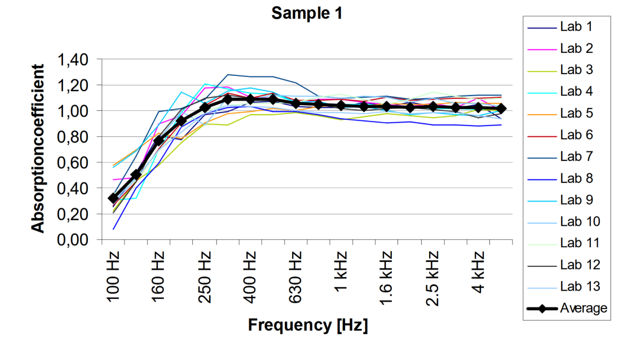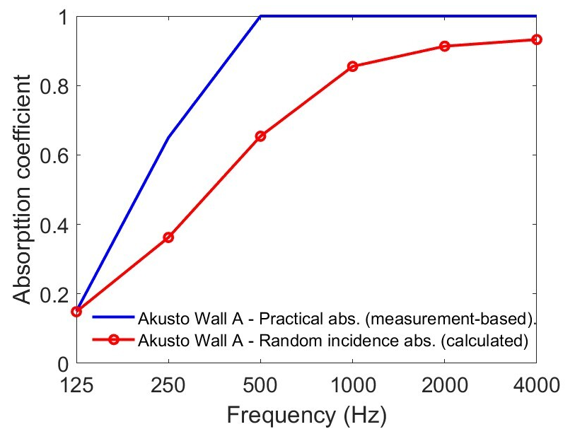How Treble handles material data
The following is an explanation of how Treble handles material data for simulation purposes. Treble’s advanced algorithm has been developed so that a user can take full advantage of the wave based solver and pressure based image source method. The wave based solver requires the use of a material’s impedance properties, but absorption coefficients are more commonplace within the field of room acoustics, in part because they are easier to conceptualize.
Consequently, while Treble uses impedance properties within the solvers (“under the hood”, so to speak), we prominently feature a material’s absorption coefficient in the user interface, both for existing materials in our database and when creating new materials.
A Treble material’s random incidence absorption coefficients and impedance values are mathematically related through ‘Paris Law’ as described here. In other words, the absorption coefficients presented in Treble are the theoretical absorption coefficient values for diffuse field conditions, corresponding to the impedance of the material.
It is important to clarify the difference between 'random incidence absorption coefficients' (what Treble calculates directly from impedance) and ‘practical absorption coefficients’ (the most common value provided by acoustic manufacturers & datasheets).
Practical absorption coefficients are highly dependent on the measurement chamber where they were collected. The variation of measured absorption coefficients has been well documented, e.g. in the following paper [1]. Figure 1, reproduced below, demonstrates the substantial variation in measured absorption coefficients of the same material in 13 different measurement chambers.

This is because both the chamber itself and the mounting of the material have great effect on the measurement, most notably at lower frequencies. Diffraction around the mounting bracket, absorption due to the sides of the material sample, as well as the fact that no reverberant chamber can fully replicate a perfectly diffuse sound field (and will therefore exhibit some modal behavior), are some of the factors that influence the results.
In practice, this means that practical absorption values from datasheets can overestimate the absorption of a material when compared with the more analytically correct solution of random incidence absorption. This discrepancy is usually most prominent for lower frequencies as demonstrated in the following figure. At higher frequencies the difference becomes less pronounced.

Why is this important and why does Treble use the random incidence absorption derived from impedance as a basis for the calculations?
Unlike pure geometrical acoustic simulation software, which are calculated in the energy domain, Treble’s software calculates in units of pressure for both our wave based and geometrical acoustics solvers.
This allows Treble to perform more advanced simulations, as exemplified in our ability to accurately simulate the reflected phase of a sound wave at a boundary. This capability enables Treble to calculate the constructive and deconstructive interference of wavefronts as they interact. The changes to a wave’s phase as it reflects off a surface is determined by the impedance of that boundary, which is not captured in the practical absorption coefficients used by energy-based geometrical acoustic simulation tools. However, by using impedance data, Treble can easily recreate this physical phenomena in both our wave based and geometrical based simulations.
Treble does however not require a user to familiarize themselves with impedance values for different surfaces, unless they wish to do so. Treble handles the calculation of impedance and random-incidence absorption coefficients automatically.
What all this means in practice is the following:
• The default materials in the material library are optimized for use in Treble and are based on empirical impedance models.
• If practical absorption values from datasheets are used to create materials within Treble it is possible that low frequency absorption values will be overpredicted as highlighted above.
• Therefore, we recommend that when creating new materials in Treble, the practical absorption datasheet values should be compared against the random incidence absorption coefficients of a similar material or construction within Treble’s existing database. This is most notable for the 63, 125 and 250 Hz octave bands.
References
[1] Vercammen, M. L. S. (2010). Improving the accuracy of sound absorption measurement according to ISO 354. In Proceedings of the International Symposium on Room Acoustics (ISRA 2010) (pp. 29–31). Melbourne, Australia.